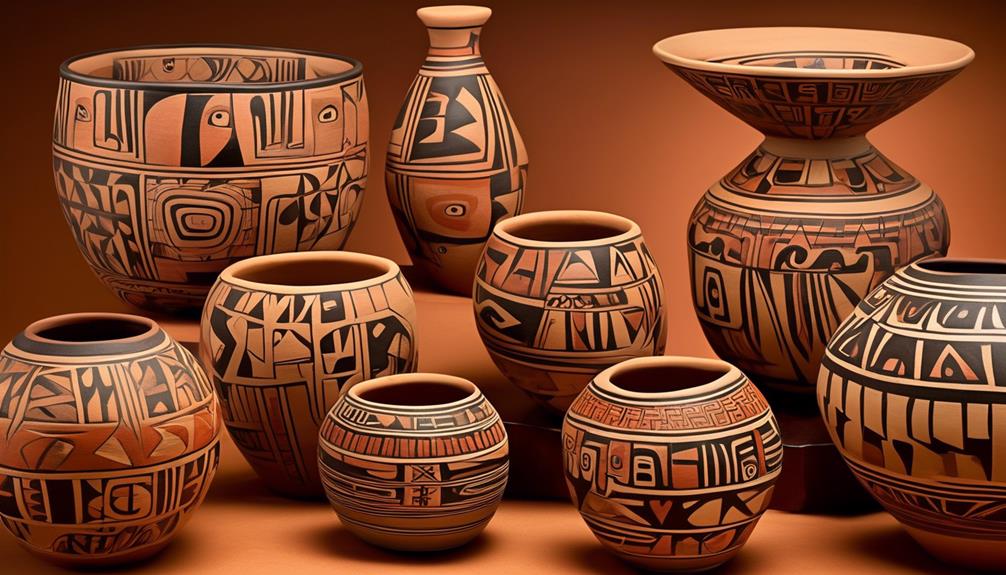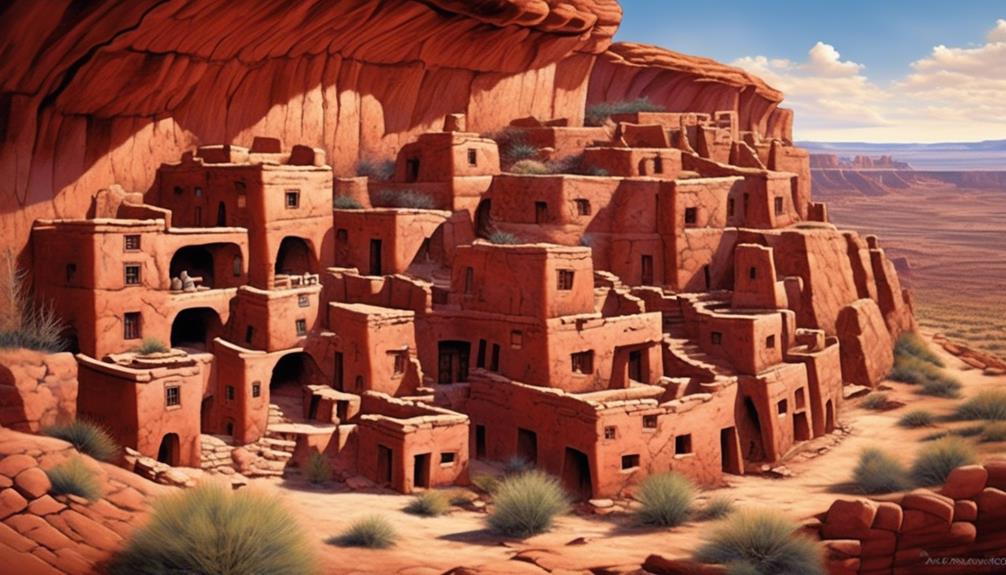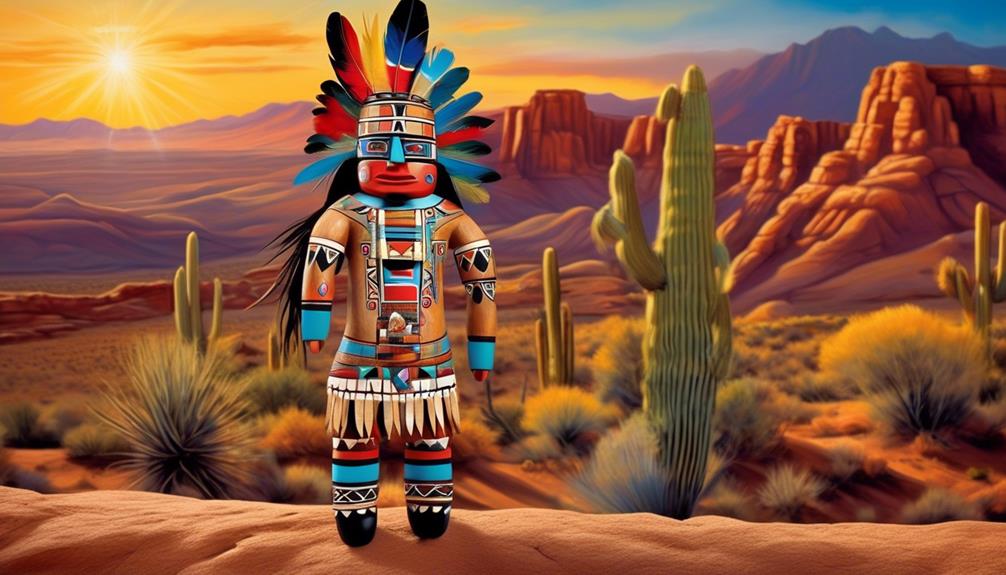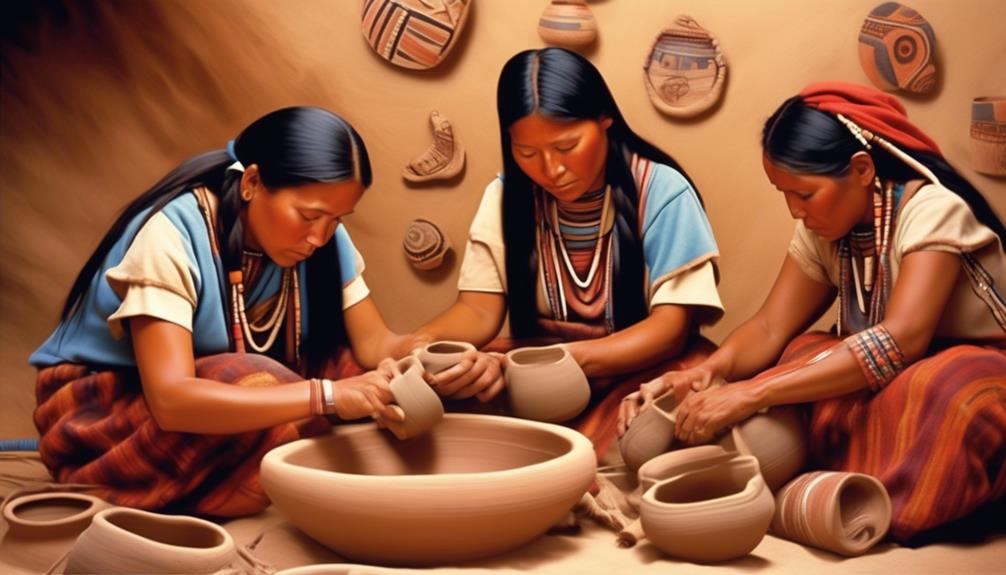As the well-known saying goes, “art is the deception that enables us to grasp the truth.” When delving into the art of the Hopi tribe, one is mesmerized by the array and profundity of expression that has been transmitted through numerous generations.
From the intricate pottery and ceramics to the colorful textiles and weavings, the Hopi people have a long-standing tradition of creating art that reflects their spiritual beliefs and deep connection to the land.
But what truly sets their artwork apart is the significance behind each piece, often embodying stories of their mythology and rituals.
Key Takeaways
- Hopi pottery techniques are considered a sacred art form, with each step in the process infused with spiritual significance.
- Traditional Hopi textiles are created using techniques that have remained largely unchanged for centuries, with designs and patterns holding deep cultural and religious significance.
- Kachina Dolls serve as a bridge between the spiritual and physical realms for the Hopi people, symbolizing different deities and ancestral spirits.
- Hopi murals and paintings depict ceremonial rituals, mythological narratives, and clan histories, serving as visual narratives of the tribe's cultural heritage and spiritual beliefs.
Pottery and Ceramics
The art of pottery and ceramics holds a central place in the cultural and artistic heritage of the Hopi tribe, embodying a tradition that spans generations and reflects the tribe's deep connection to the natural world.
Hopi pottery techniques are deeply rooted in the tribe's history and are considered a sacred art form. The process of creating Hopi ceramics involves gathering clay from specific locations, hand-coiling the pottery, and using natural pigments for painting and decorating. Each step in the process is infused with spiritual significance, and the knowledge of these techniques is passed down from one generation to the next, contributing to the preservation of the tribe's cultural identity.
The cultural significance of Hopi ceramics extends beyond the artistic realm. These pottery pieces often feature symbolic representations of elements from Hopi mythology and cosmology, serving as a visual language that communicates the tribe's values, beliefs, and history. Additionally, Hopi ceramics play a vital role in ceremonial and everyday life, with specific pottery types being used for specific purposes such as water storage, food preparation, and ceremonial offerings.
This demonstrates how the art of pottery is intricately woven into the fabric of Hopi society, reflecting the tribe's deep connection to the natural world and its spiritual beliefs.
Textiles and Weavings
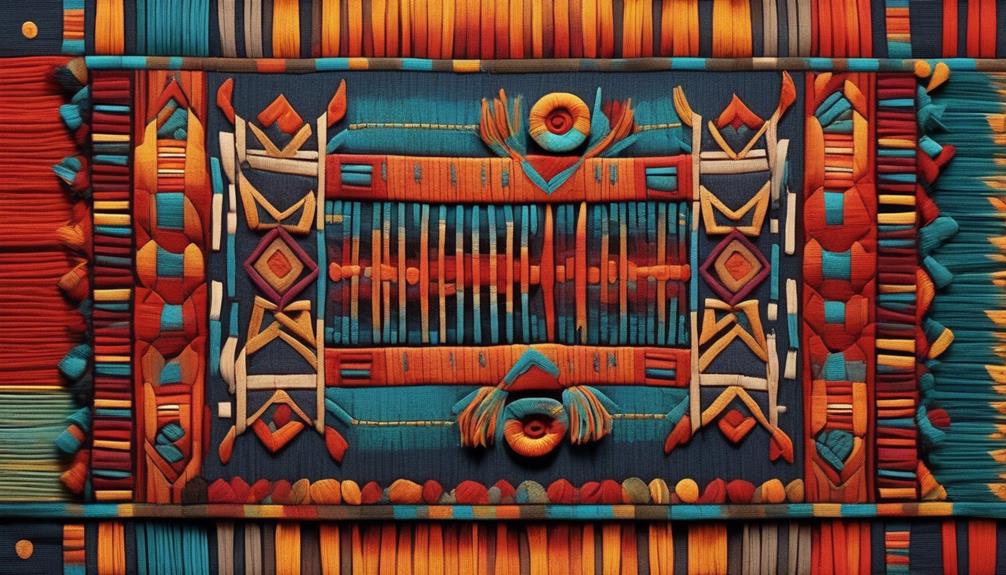
Exploring the intricate art of textile weaving among the Hopi tribe reveals a rich tapestry of cultural expression and historical significance. Textiles hold a prominent place in Hopi culture, with weaving being a skill passed down through generations. Traditional Hopi textiles are created on a vertical loom, using techniques that have remained largely unchanged for centuries. The designs and patterns woven into the textiles often hold deep cultural and religious significance, with each motif conveying stories of the tribe's history, spiritual beliefs, and connection to the natural world.
Hopi textiles serve both practical and ceremonial purposes within the community. Women are primarily responsible for the intricate art of weaving, producing items such as ceremonial sashes, shoulder blankets, and sashes for ceremonial attire. These textiles play a crucial role in various ceremonies and rituals, symbolizing the tribe's cultural identity and spiritual beliefs. The weaving process itself is a deeply spiritual and meditative practice for the Hopi people, reflecting their reverence for tradition and the interconnectedness of all things.
Kachina Dolls
Weaving a connection between the intricate art of textile weaving and the cultural significance of the Hopi tribe, the tradition of Kachina Dolls embodies a profound spiritual and artistic expression. These dolls aren't mere playthings; they hold immense cultural significance and serve as a bridge between the spiritual and physical realms for the Hopi people. Crafted with meticulous attention to detail, Kachina Dolls are a testament to the exceptional craftsmanship of the Hopi artisans. Each doll is a unique piece, reflecting the skill and dedication of the maker.
The cultural significance of Kachina Dolls can't be overstated. They're deeply rooted in the spiritual connection the Hopi people have with their ancestors and deities. These intricate dolls are used in various ceremonies and rituals, symbolizing different deities and ancestral spirits. They serve as a medium through which the Hopi people connect with their spiritual beliefs and traditions.
Despite their historical importance, Kachina Dolls have also found modern interpretations as collectible art pieces. Many contemporary artists have incorporated elements of traditional Kachina Doll crafting into their work, blending the old with the new to create unique and culturally rich pieces of art. This modern interpretation not only preserves the tradition but also ensures its continuation in the ever-evolving artistic landscape.
Murals and Paintings
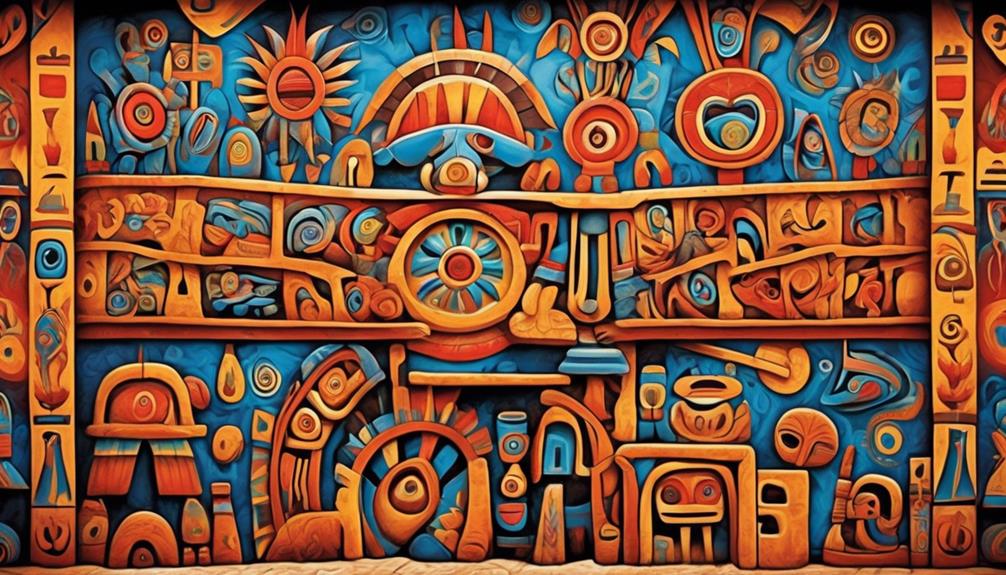
Adorning the walls of Hopi villages and ceremonial spaces, vibrant murals and paintings serve as visual narratives of the tribe's cultural heritage and spiritual beliefs. These artworks aren't merely decorative, but rather, they encapsulate the essence of the Hopi people's worldview and traditions. The historical significance of these murals and paintings can't be overstated, as they offer invaluable insights into the tribe's history and artistic techniques.
Mural Techniques:
- The Hopi people employ a unique combination of mineral-based pigments and natural binders to create their murals, ensuring longevity and vividness.
- Intricate brushwork and meticulous attention to detail characterize the mural techniques, exemplifying the artistic prowess of the Hopi artisans.
Historical Significance:
- These murals and paintings often depict ceremonial rituals, mythological narratives, and clan histories, providing a visual record of the tribe's cultural practices.
- The preservation of these artworks across generations underscores the enduring cultural heritage of the Hopi people, fostering a deep sense of connection to their ancestors and traditions.
Jewelry and Silverwork
The intricate artistry that characterizes the vibrant murals and paintings of the Hopi people finds a new expression in their exquisite jewelry and silverwork, reflecting a deep cultural connection to tradition and heritage.
Hopi craftsmanship in jewelry and silverwork is renowned for its precision and attention to detail. Traditional designs are often inspired by elements of Hopi mythology, incorporating symbols such as the migration pattern of the Hopi people, katsinas (spirit beings), and rain clouds, each carrying deep cultural and spiritual significance. The use of intricate overlay and etching techniques further highlights the skill and artistry of Hopi silversmiths, creating pieces that aren't just adornments, but also storytelling devices, preserving the rich cultural heritage of the Hopi tribe.
Hopi jewelry and silverwork aren't just decorative; they're a tangible representation of the tribe's identity and values. The art form has been passed down through generations, with each piece carrying the legacy of its makers. The cultural context of these pieces can't be understated, as they serve as a visual record of the tribe's history, spirituality, and artistic prowess.
The significance of Hopi jewelry and silverwork extends beyond aesthetics, embodying the resilience and creativity of the Hopi people across centuries.
Frequently Asked Questions
What Is the Significance of Certain Symbols and Motifs Used in Hopi Pottery and Ceramics?
Significance of certain symbols and motifs in Hopi pottery and ceramics lies in their cultural incorporation and weaving traditions.
We, as a community, honor these symbols as they carry deep historical and spiritual significance. The motifs often represent elements of nature, fertility, and the Hopi creation story.
Each symbol holds a unique meaning and reflects our tribe's connection to the land and our ancestors, preserving our cultural identity through art.
How Do Hopi Weavers Incorporate Traditional Stories and Cultural Beliefs Into Their Textiles and Weavings?
Weaving traditional stories and cultural beliefs into textiles is a deep-rooted practice for Hopi weavers. Their intricate weaving techniques embody symbolic motifs and convey the essence of their cultural heritage.
Through the incorporation of symbolic motifs such as kachina dolls, mural techniques, and jewelry meanings, the weavers bring to life the rich tapestry of Hopi traditions.
Their textiles serve as a living testament to the enduring significance of storytelling and cultural beliefs within the tribe.
What Is the Role of Kachina Dolls in Hopi Religious and Ceremonial Practices?
Kachina dolls play a vital role in Hopi religious and ceremonial practices. They embody the essence of spiritual beings and deities and hold deep religious significance. These sacred objects are intricately crafted to depict symbolic motifs that represent traditional stories and cultural beliefs.
Through the creation and use of Kachina dolls, the Hopi people uphold their cultural heritage. They connect with their ancestors and preserve their rich traditions for future generations.
Are There Specific Techniques or Materials Used in Creating Hopi Murals and Paintings?
Hopi painting techniques involve intricate use of natural pigments and detailed brushwork, reflecting their deep connection to the land.
Traditional mural materials, such as clay and natural dyes, are used to depict symbolic motifs in Hopi pottery, reflecting their cultural beliefs.
The vibrant colors and spiritual meanings in jewelry and textiles hold significant importance in the Hopi culture, mirroring their reverence for nature and the spirit world.
What Cultural and Spiritual Meanings Are Associated With Specific Designs and Materials Used in Hopi Jewelry and Silverwork?
Cultural symbolism in Hopi jewelry and silverwork encompasses deep spiritual significance. The artistic techniques used reflect the tribe's reverence for nature and their connection to the spiritual world.
Designs often depict animals, plants, and natural elements, all with symbolic meanings tied to the tribe's beliefs and traditions. Materials like turquoise and silver hold special cultural significance, representing the earth and sky in Hopi cosmology.
These intricate creations reflect the tribe's rich cultural heritage.
Conclusion
Intriguingly, the Hopi tribe's artwork includes pottery, textiles, kachina dolls, murals, and jewelry. Each piece portrays a profound connection to their cultural heritage, showcasing intricate designs and vibrant colors.
The historical significance of their artwork is intertwined with their spiritual beliefs and traditions, providing a captivating glimpse into the rich cultural tapestry of the Hopi people.
Mary is a passionate writer who brings creativity and a fresh perspective to our team. Her words have the power to captivate and inspire, making her an essential contributor to our content. Mary’s commitment to storytelling and dedication to promoting Indigenous culture ensures that her work touches the hearts of our readers. We’re fortunate to have her as part of our team.
